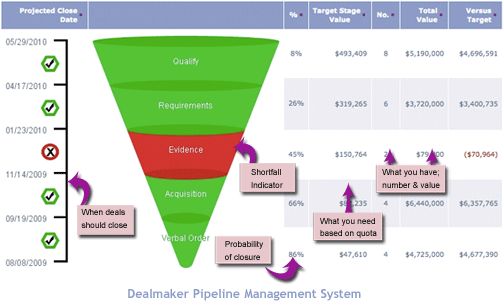I recently conducted a survey on LinkedIn to determine what sellers view as their biggest problem at the moment. The result is pretty definitive. It’s all about the pipeline baby!
So, I’ve revisited a post I did about a year ago which was called The 10 Truths of Pipeline Management. I’ve updated it to reflect the impact of Social Networks, and now there are 13 rules!
At the end of this post – after the 13 rules – I include a graphic of the Dealmaker Pipeline Snapshot, that we use here at The TAS Group, and with many of our customers, to effectively manage the sales pipeline.
- Maintaining a strong sales pipeline, with enough qualified opportunities at each phase in the pipeline, is the only way to avoid the quarter-end crunch.
- Pipeline Velocity is a lot more important that Pipeline Volume.
- Your pipeline is a better predictor of the medium and long-term health of your business than your sales forecast – and they are two very different indicators.
- Having too many stages in the pipeline is counter-productive. Six is the optimum number of stages in the pipeline.
- It is futile to determine the value of a pipeline by multiplying the value of each opportunity by the probability of it closing. You rarely get a % of a deal.
- You can’t depend solely on marketing to fill the funnel. You must generate your own leads. If you don’t look constantly for new opportunities, you lose control over your destiny.
- A healthy pipeline will have the right blend of deals, in terms of size. If you want to fill a barrel with rocks and maximize the usage of the capacity of the barrel, you have to fill the gaps between the rocks with stones or pebbles. It’s the same with your pipeline.
- Pipeline stages have no inherent value in terms of deal progression. It’s only the customer related actions tied to each stage that gives meaning to the progression of deals through the pipeline. Clear deliverables (based on evidence of customer actions) must be linked to each stage.
- You need an algorithmic measure for each stage of the pipeline to determine whether you have enough opportunities at each stage. Consider the time to close, the probability of closure, and the target revenue to calculate the value you need.
- Deals that are inactive (have not been worked on for more than 60 days) should be cleared out of the sales funnel and sent back to marketing. Otherwise you’re given a false sense of the value of your sales pipeline.
- Customers (or prospects) are entering the sales cycle further down the funnel now as they are using Social Networks to research solutions before they invite sales people into the conversation.
- Unless you’ve established yourself as part of the ‘recommendation chain’ many of these opportunities will never enter your funnel, they will be closed by someone else before you even know about it.
- Networking has always been the best way to fill the funnel – now with Social Networks you can use OPM (other People’s Money) to generate buyers – not just opportunities.
For more info on the how Social Networks can be used to impact sales, you might want to visit this other post: 10 Steps to Intelligent Social CRM for Sales.





